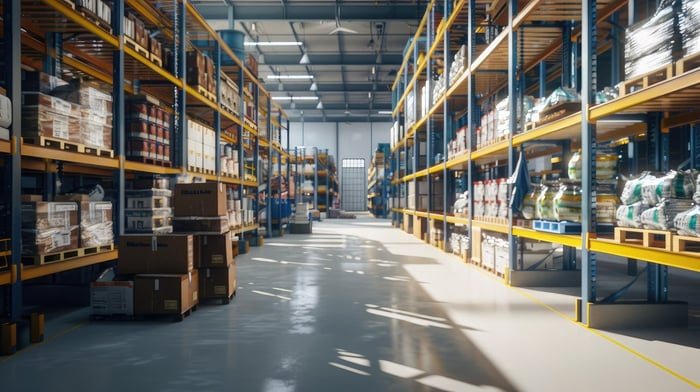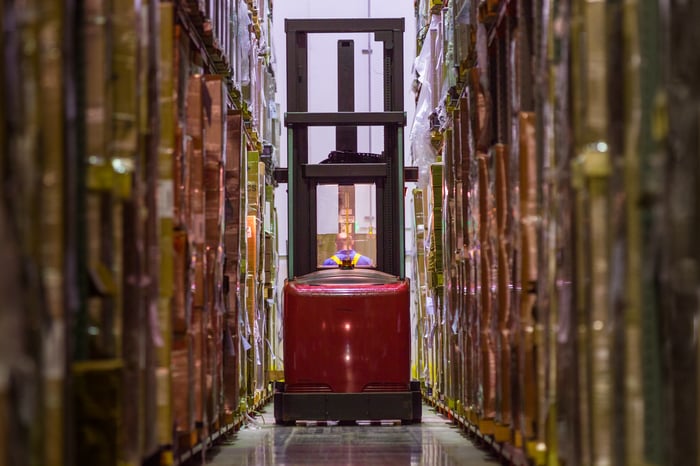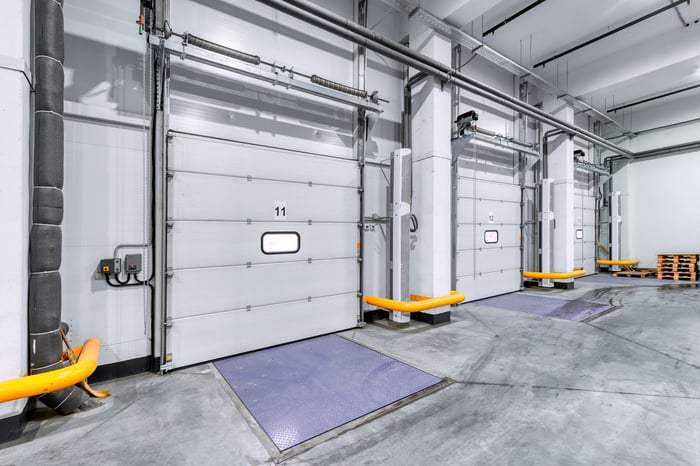In the warehouse, maximizing space and efficiency is the name of the game. One inventory system that can achieve this is pallet flow racking. This system is a common way to organize storage that provides a variety of advantages to operators.
Of course, it’s not for every type of operation, either.
So, if you want to learn if pallet flow racks are right for you, you’re in the right place. Keep reading for our ultimate guide to the subject, including who it’s best for, its pros and cons, and how to implement it in your warehouse.
What is Pallet Flow Racking?
Pallet flow racking describe storage structures made with slightly sloped channels and rollers. These structures are designed to ensure pallets slide into their proper place. The loads are placed in the highest part of the space and shifted by gravity into the opposite end, where they are removed.
Typically, the system will be configured to use opposite aisles for loading or extracting, eliminating the need for intermediate aisles and increasing storage capacity. Even more, the racking system is FIFO (first in, first out) compatible, which optimizes inventory management efficiency.
Here’s how the process typically looks:
-
The forklift loads pallets at the back of the system.
-
The pallets move forward to the opposite aisle.
-
The forklift removes the pallet at the front.
-
The rear pallets automatically move forward to fill the space.
Advantages & Disadvantages of a Pallet Flow System
When making any big change to how your warehouse works, it’s crucial to explore its advantages and disadvantages first. To help decide whether the system is right for your operation, here’s what to consider.
One of the primary benefits is its ability to maximize storage density by utilizing a first-in, first-out (FIFO) inventory management system. This ensures that older stock is used before newer stock, reducing the risk of product obsolescence or spoilage, which is particularly useful for perishable goods.
The system also increases efficiency in the picking and replenishment processes, as products automatically move to the front of the rack when a pallet is removed. This reduces the time and labor required for restocking and retrieval, leading to faster order fulfillment.
However, there are also disadvantages to consider. The initial investment can be significant, as it involves purchasing specialized equipment and installation services. Maintenance costs can also be higher than in traditional static racking systems, as the flow rails and rollers require regular inspection and upkeep to ensure smooth operation.
Additionally, it’s less flexible in accommodating different pallet sizes and weights, which can be a limitation for warehouses that handle diverse products. It also requires careful planning and design to optimize space and ensure the system meets specific storage needs.
Here’s more of a breakdown of what to consider.
Advantages
-
Maximized Storage Density: Efficient use of space by allowing multiple pallets to be stored in depth.
-
First-in, First-Out (FIFO) Inventory Management: Ensures that older stock is used before newer stock, reducing product obsolescence and spoilage.
-
Increased Picking and Replenishment Efficiency: When a pallet is removed, products automatically move to the front of the rack, reducing time and labor for restocking and retrieval.
-
Reduced Handling Time: Minimizes the need for forklifts to enter aisles, speeding up operations and reducing the risk of damage to goods.
-
Better Product Rotation: Ideal for perishable goods and products with expiration dates, ensuring consistent product quality.
-
Improved Order Fulfillment Speed: Streamlined picking process leads to faster order processing and shipping.
Disadvantages
-
High Initial Investment: Significant upfront costs may be required for specialized equipment and installation.
-
Higher Maintenance Costs: Regular inspection and maintenance of flow rails and rollers are necessary to ensure smooth operation.
-
Limited Flexibility: Less adaptable to varying pallet sizes and weights, which can be a drawback for warehouses with diverse product lines.
-
Complex Design and Planning: Requires careful planning to optimize space and ensure the system meets specific storage needs.
-
Potential for Product Damage: Products may be damaged if they are not properly handled or if the system is not well-maintained.
-
Space Requirements: The racking system and flow lanes require sufficient space, which might only be suitable for some warehouse layouts.
Overall, it’s best to discuss your options with a warehouse design specialist like BMH.
Who Pallet Flow Racking is For
As we mentioned at the beginning of our guide, this system is not for everyone. It works best for a few types of warehouses or inventories. Review those now to get a better idea of whether you should consider this type of system.
-
Large scale and high turnover: These systems are ideal if you have to store multiple units per SKU.
-
Perishable product storage: This type of system specifically benefits products with expiration dates, such as food and pharmaceuticals.
-
Cold storage: Due to the high-density nature of the system, you can reduce energy use in refrigerated warehouses.
All in all, pallet flow racks are ideal for connecting two working areas, usually production and dispatch because they use opposite ends of the aisles. They also serve as a buffer management tool and speed up the flow of goods in temporary storage areas, such as when orders are to be picked up.
How to Implement Pallet Flow Racking
Implementing this type of system in a warehouse involves several vital steps to ensure a successful installation and efficient operation. First, conduct a thorough inventory analysis to determine the suitability of the racking, focusing on factors like product turnover rates, dimensions, and weight.
Next, measure the available space and plan the layout, considering the optimal configuration for the flow lanes and the overall racking system to maximize storage density and accessibility. Consult with a specialized racking supplier to design a system tailored to your warehouse's needs and ensure it meets safety and operational requirements.
After finalizing the design, proceed with the installation, ensuring all components are securely fitted, and the flow rails are appropriately aligned for smooth pallet movement. Finally, train your staff on the new system, covering best practices for loading and unloading pallets, regular maintenance checks, and troubleshooting common issues.
The Final Word: Pallet Flow Racks
Let’s be honest. Nearly any and every warehouse operation could use some improvements. Whether maximizing space, optimizing workflows, or reducing errors, no one operation is perfect. If you’re in a position to improve your warehouse operations with either pallet flow racks or other systems, BMH can help.
BMH is your all-in-one source for material handling and inventory. We offer a variety of product lines, from pallet racks to shelving, conveyors to mezzanines, forklifts, and beyond. We enable manufacturers, distributors, and logistics providers to get what they need where they need it most efficiently.
To begin your warehouse consultation for supplies or services, contact our team. Send us a message, or get in touch with a specific location directly.




